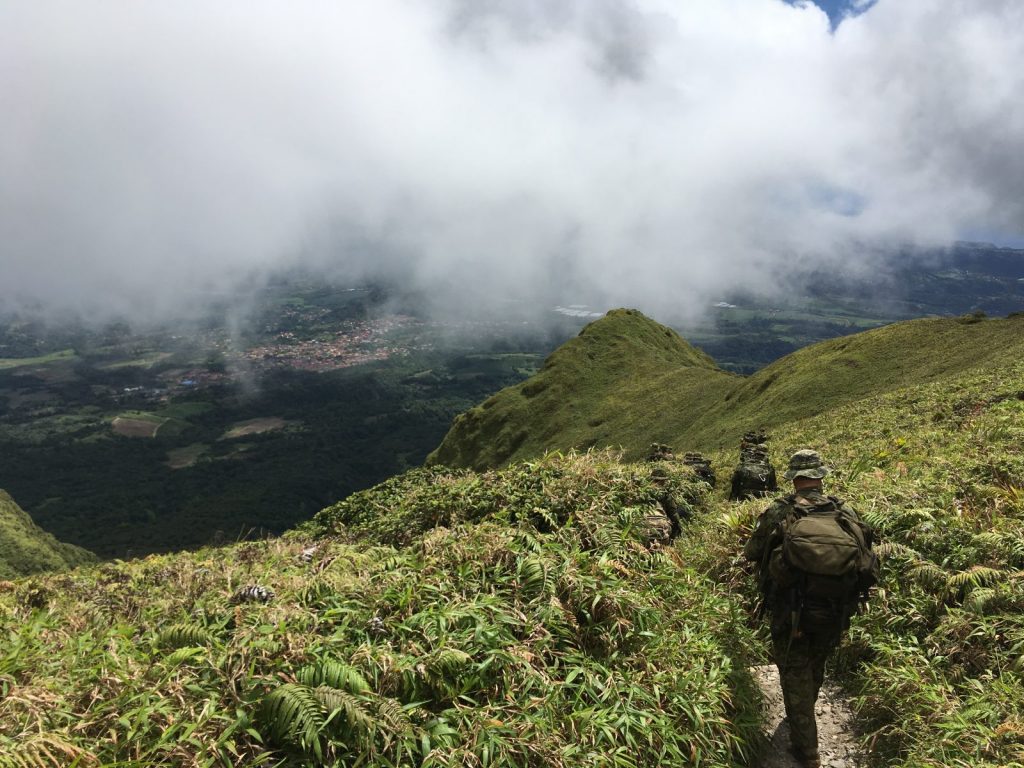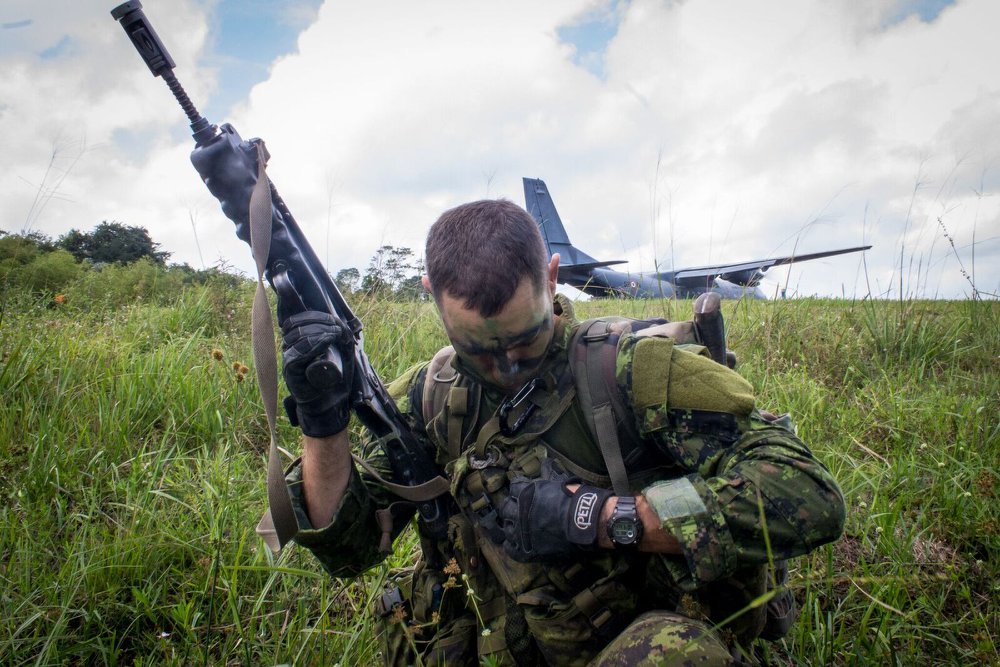How a Brazilian exchange officer is helping the Army develop its jungle warfare doctrine and train future specialists.
by Ian Coutts
Sometimes it really is a jungle out there. And when it is, the Canadian Army may have to respond.
That isn’t easy. The jungle environment is hostile in particular ways. Movement overland is difficult. It’s an unhealthy, dangerous world, a home to large predators, poisonous snakes and insects, and hair-raising diseases such as Leishmaniasis, which can leave its victims with disfiguring facial lesions. It’s an environment where a seemingly inconsequential cut can quickly become purulent. That’s all before people start shooting at you.
This October, a platoon of soldiers from B Company of the 3rd Battalion, Royal 22e Regiment (3 R22eR), together with a few soldiers from other units at Canadian Forces Base (CFB) Valcartier, headed south to French Guiana. Their destination was Centre d’entraînement à la forêt équatoriale (CEFE), the French Army jungle warfare school there run under the direction of the Foreign Legion, where they participated in an exercise called Ex Spartiate Equatoriale.
Accompanying them for the two-week jaunt were Sergeant Jonathan Bujold, previously a member of the battalion now attached to the pathfinder platoon located at CFB Trenton, and a Brazilian officer, Captain Ronaldo de Souza Campos. Souza Campos, an instructor from Centro de Instrução de Guerra na Selva (CIGS), the Brazilian Army’s jungle warfare school located in the city of Manaus, far up the Amazon in the jungle, is currently on a posting with the Canadian Army, working out of the Canadian Army Advanced Warfare Centre (CAAWC) in Trenton.
The immediate purpose of the program was to give the soldiers on the course firsthand experience operating in a jungle environment—not something available in Valcartier or indeed anywhere in Canada.
The larger goal—and why Bujold and Souza Campos went along—was to build skills and expertise to deliver future capability. Through courses like this, and drawing on the experience of experts like Souza Campos and others, the Army wants to create a pool of experts and a written doctrine to guide them so that if it is ever committed to serving in the jungle, soldiers will be ready.

SPECIALIZED TRAINING
However unlikely the Army’s need for skills in jungle warfare might seem, it has its origins in firsthand experience. In 1999, a 250-strong contingent of soldiers from 3 R22eR was sent to East Timor for six months as part of an international peacekeeping force. Warrant Officer Philippe Paquin-Benard, a current member of the battalion and one of its resident jungle warfare experts, outlined their experience: “Nearly 45 percent encountered major problems related to limited knowledge and inadequate equipment for this type of severe and complex environment.”
The Army had previously sent instructors to the French school in 1994, but, said Paquin-Benard, “the expertise had practically disappeared.” The Army had also in the past created its own manuals for jungle warfare, but they had not been revised since at least the early 1980s.
Consequently, 3 R22eR was tapped to develop expertise in jungle warfare, a process that has been moving forward with baby steps for more than a decade. A 2008 exchange by the battalion’s reconnaissance platoon with the Royal Gurkha Rifles in Brunei demonstrated that, despite their generally high level of fitness and military know-how, work had to be done on particular skills needed in jungle warfare before would-be trainees showed up.
This meant sending individuals on specialized courses, such as the international 10-week Jaguar course at CEFE (which Paquin-Benard attended with a colleague in 2014), the British Army’s Jungle Warfare Instructor Course in Borneo (which Bujold is a graduate of), or similar courses at the Brazilian school in Manaus. Soldiers from the 3 R22eR also visited the French Army Jungle Warfare School in Martinique in 2014 and 2016. The idea was to create a core group of instructors who could prepare the rest for what they would face in the jungle.
In 2013, the Brazilian and Canadian armies concluded an agreement that has seen a Brazilian exchange officer sent north to CAAWC on a two-year secondment to help develop jungle warfare doctrine. Souza Campos, the current exchange officer, is a 16-year veteran of the Brazilian Army who previously served as an instructor at CIGS. (Bujold is his second-in-command subject matter expert.)
Jungle warfare is a particular specialty of the Brazilian Army, where the jungle areas are vast and touch on the borders of more than half a dozen other countries. “There are many problems with cross-border crimes such as drug trafficking and arms smuggling,” explained Souza Campos, and it is the army’s job to try and stop them, and CIGS’s job to teach them how to go about doing this.
In addition to training Brazilian military and police, CIGS regularly attracts students from around the world who take a special seven-week course taught in English. Since 2016, a section-sized group from 3 R22eR has travelled to Manaus each year to take part in a jungle warfare competition at the centre. (The Canadian and Brazilian armies recently renewed this agreement for another four years.)

SETTING NEW STANDARDS
So much has changed since the 3rd Battalion undertook its exchange with the Gurkhas in 2008. Before deploying to French Guiana, every soldier going on the course passed through a two-day selection process to make sure that they had the needed physical skills, particularly swimming, to ensure they could do the course, said Paquin-Bernard. This was followed by a few weeks training to prepare them for the jungle environment, including instruction on the flora and fauna they were likely to encounter.
In addition, “a significant emphasis was put on … hygiene and individual medical care,” he said. The battalion now has this kind of expertise in-house.
For Souza Campos and Bujold, the trip was an opportunity to see whether the standards that they and Souza Campos’s predecessors have been evolving for Army jungle warfare doctrine are being met in training, and whether these standards might, in fact, need to be modified in the face of field conditions.
In the short-term, the goal will be to create a concise manual or handbook that can be given to soldiers going on a jungle warfare course. In the longer run, the goal is to create a set of standards, known as a Quality Standard Training Plan, or QSTP, that will outline what standards any soldier must meet to be fully jungle qualified.
Beyond that, said Bujold, is an even more ambitious dream: At present, the French Army does not permit qualified Canadians to instruct at its school. “What we are trying to do in the long-term is find another place in the world, perhaps with the U.K. or Brazil, where our instructors will be able to teach.”
Our own location, our own doctrine, and our own trained instructors. In the words of Guns ‘n’ Roses, “Welcome to the jungle.”


In the 60s and 70s we did these courses with the US Army in the Panama Canal Zone and the Australian Army at Canungra in Queensland. We took whole battalions to Jamaica for four to six weeks to practice what the instructors passed along.